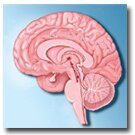Brain Waves Can 'Write' On A Computer In Early Tests
 Neuroscientists at the Mayo Clinic campus in Jacksonville, Fla., have demonstrated how brain waves can be used to type alphanumerical characters on a computer screen. Neuroscientists at the Mayo Clinic campus in Jacksonville, Fla., have demonstrated how brain waves can be used to type alphanumerical characters on a computer screen.
By merely focusing on the "q" in a matrix of letters, for example, that "q" appears on the monitor.
Researchers say these findings, presented at the 2009 annual meeting of the American Epilepsy Society, represent concrete progress toward a mind-machine interface that may, one day, help people with a variety of disorders control devices, such as prosthetic arms and legs. These disorders include Lou Gehrig's disease and spinal cord injuries, among many others.
"Over 2 million people in the United States may benefit from assistive devices controlled by a brain-computer interface," says the study's lead investigator, neurologist Jerry Shih, M.D. "This study constitutes a baby step on the road toward that future, but it represents tangible progress in using brain waves to do certain tasks."
Dr. Shih and other Mayo Clinic researchers worked with Dean Krusienski, Ph.D., from the University of North Florida on this study, which was conducted in two patients with epilepsy. These patients were already being monitored for seizure activity using electrocorticography (ECoG), in which electrodes are placed directly on the surface of the brain to record electrical activity produced by the firing of nerve cells. This kind of procedure requires a craniotomy, a surgical incision into the skull.
Dr. Shih wanted to study a mind-machine interface in these patients because he hypothesized that feedback from electrodes placed directly on the brain would be much more specific than data collected from electroencephalography (EEG), in which electrodes are placed on the scalp. Most studies of mind-machine interaction have occurred with EEG, Dr. Shih says.
"There is a big difference in the quality of information you get from ECoG compared to EEG. The scalp and bony skull diffuses and distorts the signal, rather like how the Earth's atmosphere blurs the light from stars," he says. "That's why progress to date on developing these kind of mind interfaces has been slow."
Because these patients already had ECoG electrodes implanted in their brains to find the area where seizures originated, the researchers could test their fledgling brain-computer interface.
Source: Mayo Clinic
|